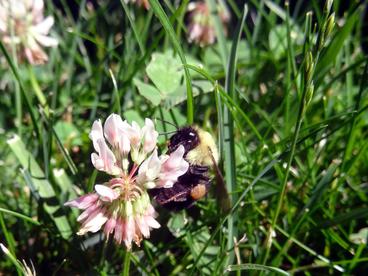
The Lawns to Legumes Program, which is managed by the Minnesota Board of Water and Soil Resources (BWSR), offers a combination of workshops, coaching, planting guides and cost-share funding (individual support grants) for installing pollinator-friendly native plantings in residential lawns. The program also includes demonstration neighborhoods, which are pollinator programs run by local governments and nonprofit organizations with support from BWSR, and a public education campaign to raise awareness about creating pollinator habitat. BWSR is partnering with Metro Blooms and Blue Thumb – Planting for Clean Water to administer the program. Find details on Individual Support Grants, Demonstration Neighborhoods, public outreach and more at the bottom of this web page.
Minnesota is home to more than 450 native bee species. Pollinators also include butterflies, moths, beetles and native flies. All play a key role in pollinating many food crops and native plants, but populations have significantly declined worldwide in recent years. Population decline can be attributed to habitat loss and lack of related nutrition for pollinators, as well as pesticide use and pathogens. Lawns to Legumes seeks to combat population decline by creating new pollinator habitat and habitat corridors that provide food sources and nesting space for pollinators. The program emphasizes protection of at-risk species, such as Minnesota's state bee, the federally-endangered Rusty patched bumble bee.
Funding is provided by the Environment and Natural Resources Trust Fund (ENRTF) and is targeted in priority areas to benefit the Rusty patched bumblebee and other at-risk species.